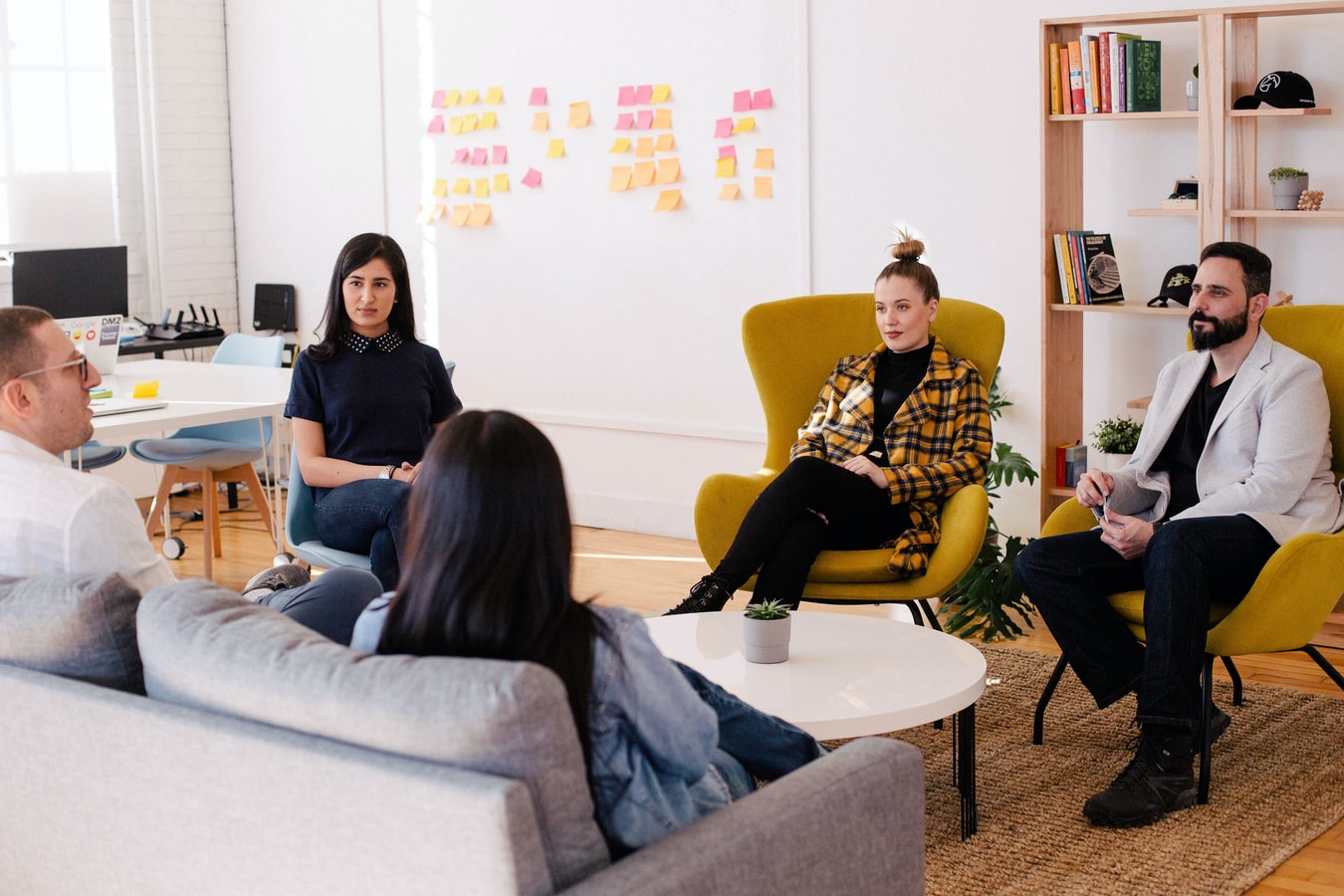The materiality analysis is one of the basic instruments of sustainability reporting and provides an ideal starting point for a stakeholder dialogue. This is because it provides answers to the three important questions when determining material sustainability aspects (based on the Definition of the German Sustainability Code):
- Point of view of the stakeholdersWhich sustainability aspects are particularly relevant for the company's stakeholders?
- Perspective from the companyWhich company activities have a particular influence on sustainability aspects relating to the environment and society?
- Perspective on the companyWhich environmental and social sustainability aspects have a particular impact on business activities today or in the future?
Expert interviews, numerous workshops and surveys with internal and external stakeholders are usually conducted to answer the questions. As part of this process, dedicated input is obtained from customers and investors through to management and employees.
Contents
- Potential of the materiality analysis for the stakeholder dialogue
- Stakeholder dialogues as a win-win for all sides
- Dialogues with a large number of stakeholders (multi-stakeholder dialogue)
- Dialogues with a small number of individual stakeholders
- Further fields of application of the materiality analysis
Methods and best practice for sustainability in your mailbox

Using the far-reaching potential of materiality analysis for stakeholder dialogue
The analysis and data collection process results in a very large pool of data. In addition to being used for sustainability reporting, this offers many other potentials. Depending on the survey design, detailed analyses can be carried out with regard to individual stakeholder groups and/or sustainability aspects.
The following graphic shows an example of the relevance distribution of the sustainability aspect "water consumption in production" in an industrial company for various internal and external stakeholder groups. It can be seen that the topic is categorised as particularly relevant for a responsible company by the group of investors. This finding can be used specifically in stakeholder dialogues. The potential uses of the results from the materiality analysis therefore go far beyond their use in sustainability reporting.

Stakeholder dialogues as a win-win for all sides
The materiality analysis therefore helps to systematically design the stakeholder dialogue. In short, the term stakeholder dialogue describes a variety of formats to enable an open exchange between internal and external stakeholders. When designing these dialogues, four questions need to be answered accordingly.
- Which Topic will be the core of the dialogue?
- Which Stakeholder groups should participate?
- Which Format offers the best probability of success?
- Which Added value should arise for all sides?
Finally, the materiality analysis can provide important input for answering the first two questions. We also answer questions 3 and 4 below based on our consulting experience.
Comparison of the key sustainability topics with the stakeholder groups in a matrix
The results of the materiality analysis enable all stakeholder groups surveyed to compare the key sustainability aspects. The preparation in the form of a matrix is therefore appropriate. The following figure shows an example of a stakeholder aspect matrix. The colouring visible there shows which topics are of high, medium or low relevance for the respective stakeholder group. This indicates which aspects must be discussed in large dialogues with representatives of all stakeholder groups - and which can be discussed in more individual, smaller dialogue formats with individual stakeholder groups.

Dialogue with a large number of stakeholders (multi-stakeholder dialogue)
The materiality analysis provides the stakeholder dialogue with further information in addition to the content. A dialogue with various stakeholder groups is necessary if the materiality analysis shows that a topic is highly relevant to many. In addition, companies should have unresolved challenges on this topic and be open to ideas for solutions.
The most important points for dialogue with a large number of stakeholders at a glance:
- Derive topics from the relevance assessments in the materiality analysis.
- In addition to the stakeholder groups surveyed for the materiality analysis, also invite representatives of non-surveyed stakeholders to the dialogue.
- Utilise accessible formats in the form of purely digital or hybrid (digital and face-to-face) events wherever possible.
- Utilise the knowledge and experience of stakeholders to develop solutions and/or better understand problem areas.
- Sustainable implementation of the dialogue through a combination of large dialogue forums and exchange formats that operate throughout the year, e.g. through advisory boards.
Determine the right topic and invite the right group of participants
In the example evaluation shown, it can be seen that the Topic diversity" is ideal for a major stakeholder dialogue. After all, it is highly relevant for internal and external stakeholders. It therefore lends itself to the Circle of participants as broadly as possible. It is important that, in addition to representatives of the stakeholder groups surveyed, the group of participants also includes non-interviewees if the company's activities have a direct or indirect impact on them. These could be, for example, representatives of indigenous peoples, labour movements or scientists. In the specific example of the topic of "diversity", for example, representatives of LGBTI* organisations and religious associations as well as experts on inclusion would be necessary.
The Summit as a suitable format for a major stakeholder dialogue
As Format For a dialogue with a large number of stakeholders, large event formats with many small topic rooms, but also space for cross-topic exchange, are ideal. This can be implemented in the form of a summit. This gives participants the opportunity to contribute and define the topics for the themed rooms themselves. This means that the event is not predetermined by the inviting company and is characterised by openness to a variety of possible topics. Only the results of the materiality analysis limit the possibilities for the topic areas.
Hybrid formats (digital and face-to-face access) or purely digital formats should always be preferred in order to enable the most barrier-free access to the dialogue possible. This allows participants to take part regardless of their mobility and geographical distance. Tools such as wonder.me to.
A broad spectrum of added value is possible
Depending on which Added value to be achieved, the topic rooms can be organised in various workshop formats. The objectives can be, for example, to find ideas for previously unsolved challenges in the company or to expand the understanding of the problem. In the latter case, management representatives take on a listening and questioning role, but do not argue. The representatives of the other stakeholder groups describe their understanding of the problem, their positive and negative experiences and approaches to solutions that they know from other cases.
Regardless of which added value is the focus, it is important to note that stakeholder dialogue is not about presenting the company for image purposes. In order to generate sustainable added value, it is important to anchor the stakeholder dialogue on a recurring basis until a set goal has been achieved. Complementing an annual dialogue forum with institutions such as a diversity council as an exchange format during the year is highly recommended for this purpose. Discussions of problems, exchange of experiences and the development of solutions can thus take place continuously. In order to improve the acceptance of the "advisory board" among all stakeholder groups, the annual dialogue forum can also serve as an election event. The stakeholder groups thus directly elect the members of the "Advisory Board".
Dialogue with a small number of individual stakeholder groups
In our example excerpt on the materiality analysis and stakeholder dialogue of an industrial company, it is clear that the Topic "Water consumption in production" is particularly relevant for the group of investors. The Circle of participants for the dialogue is therefore much easier to narrow down. Here too, however, it is important not to focus solely on the stakeholders surveyed, who are generally already connected to the company. Potential investors should also be taken into account.
The possible Formats The opportunities for dialogue with representatives of fewer stakeholder groups are diverse. The spectrum ranges from small congresses and individual interviews to regular digital coffee talks. The selection of the right combination therefore depends very much on the Added value off. Our experience shows that a procedure with the following three steps promises a high degree of success.
Three steps from materiality analysis to stakeholder dialogue to find the right format
Step 1: Surveying the stakeholder group in order to obtain more detailed information on their particularly pronounced relevance assessment in the materiality analysis. Specifically, this means asking investors whether the topic of "water consumption in production" is included in rating procedures, negative lists or resource balancing, for example.
Step 2: Analyse the company's existing challenges in the area of "water consumption in production". Building on this, develop interactive formats that aim to utilise the expectations and experiences of stakeholders in order to positively influence the challenges.
Step 3: Select the appropriate dialogue format based on the results from steps 1 and 2. Workshops (analogue or digital) are suitable for developing solutions together. This is ideal if the company is facing unresolved challenges in the respective sustainability topic. Alternatively, if the stakeholders are not satisfied with previous solutions. Short-term formats such as coffee talks, on the other hand, are particularly good for establishing a regular dialogue. After-lunch events lasting around 30 minutes are becoming increasingly popular. The combination of intensive two- to three-hour workshops and monthly coffee talks has proven to be particularly promising.
From materiality analysis to stakeholder dialogue, sustainability strategy, product development and other fields of application
The wealth of data from the materiality analysis can be used in many other strategy and development processes within the company. Further use cases are discussed in various sequels to this article. In the first follow-up article, we explain the transition from the materiality analysis to the sustainability strategy. This is followed by an article on how the results of the analysis can be used in product development to reduce negative environmental and social impacts.
[glossary_exclude]
Are you planning the next steps towards sustainability?
Ask me for a free information meeting.
I am ready with advice and pleasure.
Michael Jenkner
Sustainability strategy and reporting topics

One comment
Comments are closed.